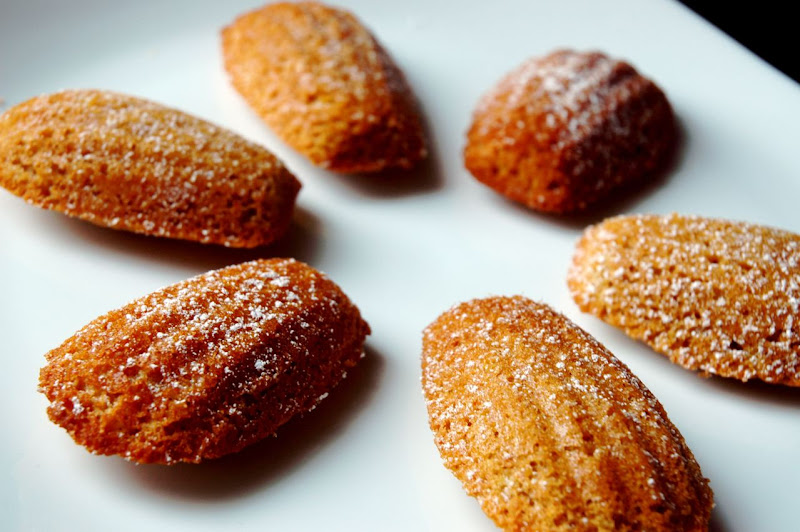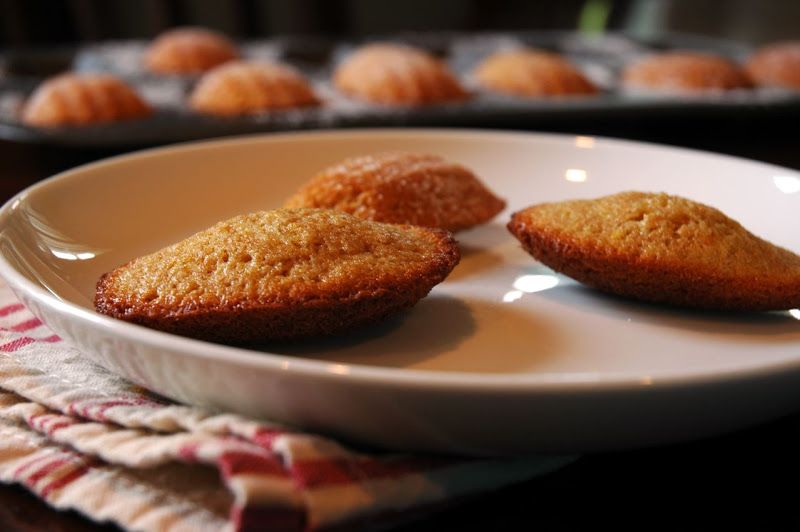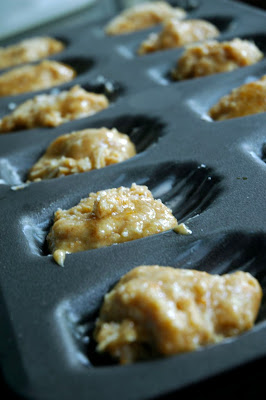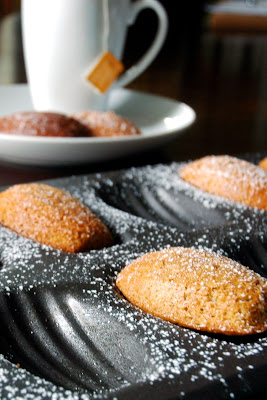Kumquat Madeleines
You should, under no circumstances, make these madeleines. Put down the scalloped pan and step away from the stove. Why? Because they are good. They are good in that "oooh, can't I have just a little bit more?" kind of way that can be very dangerous. For me, this is dangerous because, while I have made some health improvements, they aren't exactly super healthy. And because if they are within arm's reach I magically find a half eaten madeleine in my hand without any earthly idea how it got there. Amazing variety of Madeleines My humps, my humps, my lovely Madeleine bumps Kumquat Madeleines Recipe
But I made them as an act of love because madeleines are absolutely my husband's favorite. For him, they are a worthy indulgence. And he was quite effusive in his appreciation. If I can translate the crumb-stuffed statement, I believe he just said, "Oh God these are so goods. These are the best madeleines ever." I think the flavor on these is spot on: it captures the subtle flavoring that, to me, is as much the essence of the madeleine as its characteristic clam shape. Yet it harnesses that subtlety in a slightly unexpected direction, as each bite contains a hypnotic hint of tangy and unexpected kumquat balanced out by the subtle caramel undertones of Mexican vanilla extract.
En route to this, my first foray into madeleine making, I researched dozens of tempting recipes by food bloggers. That research lead me to several observations about the state of the madeleine, and also built the foundations for my deeper understanding of the art and science of the perfect madeleines. For my tooth, the consistency of this first effort is imperfect, but not necessarily because of the recipe ingredients. I believe it is because I followed short-sighted directions in preparation. But I believe that learning experience has gotten me steps closer in the pursuit of the perfect madeleine. Want to browse the wide variety of madeleine flavors out there, unlock the secrets of those characteristic humps, or learn how to make your own kumquat madeleienes? Well then 
I hadn't really thought of lumpy baked goods before as something to be sought out, but while researching I learned that the holy grail of madeleines is the characteristic hump on the back. For those in search of humps, Lebovitz recommends "freezing the prepared molds before baking plus chilling the batter for at least 3 hours in advance seems to help." Indeed, most who proffer some concrete advice for hump-enthusiasts focus on the importance of refrigerating the dough, freezing the pans etc.
Now I actually think that may all be a bit of misplaced attention, because I am newly convinced that the science behind the humps is the same gastro-technology behind the mythical perfectly risen souffle: getting good structure out of the eggs. I have a scheme to use the same set of ingredients with a slightly varied production process. Keep tuned and I'll let you know if I have unlocked the secret to the holy grail of humps.
Ingredients
6 tablespoons salted butter, melted and cooled
2/3 cup whole wheat pastry flour (sub regular is ok)
2 large eggs
1/2 cup sugar
pinch of salt
3/4 teaspoon baking powder
grated zest of 6 kumquats
juice squeezed from 4 kumquats
1 teaspoon Mexican vanilla extract (or sub regular)
1/2 teaspoon almond extract
If you are the kind of person who, after years of practice, reflexively begins to preheat the oven before beginning a recipe, stop right there.
In order to achieve that holy grail of madeleine baking--the coveted "bump"--you will probably need to exercise a little will power and put this tasty batter into the fridge before baking. Most recipes seem to recommend for a minimum of three hours and up to two days. I refrigerated mine overnight and baked them fresh in the morning.
On the other hand, if you just can't delay gratification and you don't care about bumps, then bake away! I give you permission.
Preparation
The instructions I was following advocated: "Working in a mixer bowl, or in a large bowl, rub the sugar and lemon zest together with your fingertips until the sugar is moist and fragrant." Which I did with the kumquat zest and juice when I first made these. However, given my new insights into the chemistry behind the bump, I would actually advice a slightly revised process, which I will detail here. If you prefer to follow the original Dorie directions, see the link above.
Whisk together flour, baking powder and salt.
Separate the egg yolks and whites. Begin beating the egg whites in a stand mixer with a whisk attachment on medium high until past the frothy stage, but before soft peaks. You want approximately three times the starting volume. If separately whisking and juicing kumquats seems like a pain, you may remove the seeds and then blend the whole kumquats. However, you want to be sure that you can blend the zest to a very fine grain so no large pieces remain. Alternately, remove the zest with a microplane zester first, and then blend the remaining kumquat whole rather than juicing it. If using whole blended kumquat, you will likely need only 3 or 4 total.
While egg whites are beating, vigorously whisk the yolks in a separate bowl with a wire whisk or fork. Zest kumquats with a microplane zester to produce very fine zest. Combine the vanilla extract, almond extract, kumquat zest and juice to the yolks. Whisk to combine.
Once egg whites are doubled or tripled in volume, begin adding the sugar a bit at a time, whisking well to incorporate.
Continue whisking about 2 minutes after incorporating all of the sugar then add the flavored yolks mixture and whisk briefly until just combined. The egg whites will deflate somewhat with the introduction of the fats from the yolk and the alcohol in the extracts.
With a spatula, scrape egg mixture on top of dry mixture and gently fold to combine. The mixture will be very wet.
Allow to rest 5 minutes before chilling or baking to prevent large holes in the finished crumb.
If you will chill the batter, press plastic wrap into the surface and store in the fridge for 3 hours to 2 days.
To Bake Preheat oven. I used a temperature of 350 F to bake in my dark non-stick pans (I know not the ideal traditional pans, but they are what I have). If using lighter metal pans, increase temperature to 400 F
Preheat oven. I used a temperature of 350 F to bake in my dark non-stick pans (I know not the ideal traditional pans, but they are what I have). If using lighter metal pans, increase temperature to 400 F
While oven is preheating, butter your pans. If using a pan other than non-stick, butter and flour the shells. I used butter even in the non-stick pan to help with the browning, but no need for flour in a non-stick.
After the pan is buttered, put the pan into the freezer until well chilled. This only took about 3 minutes with my pans.
Scoop "the right amount" into each small well. Lebovitz suggests that some people find this a difficult matter to judge and I side with him: go with your gut. If you aren't sure, check out the photo at left where I show how much I put in.
Do not spread the batter around within the mold; allow it to mound naturally in the pan.
Bake on a rack in the center of the oven.
If using a standard sized madeleine pan, bake approximately 11-15 minutes.  The baking time depends ultimately on the temperature of your oven and the characteristics of your pan. Check after about 10 minutes just to be sure you are on the right track. In the end you want a slightly golden edge forming near where the madeleine meets the pan, and when pressed the tops should spring back rather than leave an indentation. If you get the sense that you are nearly there, check back about every minute, because I found the transformation from "almost right" to "just right" happened in under 60 seconds of additional cook time.
The baking time depends ultimately on the temperature of your oven and the characteristics of your pan. Check after about 10 minutes just to be sure you are on the right track. In the end you want a slightly golden edge forming near where the madeleine meets the pan, and when pressed the tops should spring back rather than leave an indentation. If you get the sense that you are nearly there, check back about every minute, because I found the transformation from "almost right" to "just right" happened in under 60 seconds of additional cook time.
Remove madeleines from pan to a wire rack to cool. When slightly warm, dust with powdered sugar. Serve warm or room temperature.
Storage
The recipe I was following advocated: "the madeleines should be eaten soon after they are made. You can keep them overnight in a sealed container, but they really are better on day 1. If you must store them, wrap them airtight and freeze them; they’ll keep for up to 2 months." I found that not completely true, or at least a bit of an overstatement. They were delicious warm from the oven, which of course only happens on Day 1. However, my husband and I stored them in a tupperware that sat on the counter and they were good eatin' for up to a week. Although that may depend on the ambient temperature and humidity where you live.






8 comments:
oh good lord...how'd you know? I have a weakness for all things kumquat. I might just have to buy a madeleine pan just for this awesome recipe :)
These seem really interesting. I've been bookmarking a ton of madeleines lately. Many of the ones you mentioned. I know I should certainly heed your warning. Self-control is difficult to come by...
Julie, if you like kumquat, you'll have to keep checking back. I pretty much cooked/baked my way through half a pound of kumquats in a variety of different ways. Kumquat camomile tarts coming your way soon1
Cookinpanda, I got caught in that same "hmmm madeleines" moment. It was delicious though. will power sometimes a tad over rated.
Hey! Found your blog while looking for people who might be interested in our blog, Dinner Tonight at www.marthastewart.com/dinnertonight. Would love to hear any thoughts or tips you have on food blogging. Feel free to shoot me an email.
Thanks!
Alison Sickelka
asickelka@marthastewart.com
Hello fellow Chicagoen! Ooooh, do I have a surprise for you!
http://egov.cityofchicago.org/city/webportal/portalEntityHomeAction.do?entityName=Farmers+Markets&entityNameEnumValue=184
I market in Daley Plaza on Thursdays, but will definitely be heading up to the Evanston one at some point this summer.
so i have only tried kumquats a couple of times. but i have trouble finding them... here in sunny california!! is there a month they are more in season... ?
aracely, glad you asked, because I just learned a lot about kumquats that I probably should have researched first before this post.
First of all, according to wikipedia kumquats are in season in late autumn and early winter. And in case you just worked out that math, that means we aren't growing them in the Midwest. Kumquats grown in the US are mostly grown in the South, particularly Florida.
We got this big batch in mid-May from Trader Joes. They may not be available any longer. You could certainly substitute orange or another member of the citrus family.
(and actually there's some academic bru-ha-ha about whether or not to include kumquat in the family citrus. interesting stuff if you geek out on those things like me)
Erin, this is a great post...I love it. Luckily for me I can make a batch of madeleines and my sons will eat them all immediately...I actually have to set two aside for Dave and I, otherwise we'd get none.
Thanks for the great idea...kumquats are so tasty.
Post a Comment